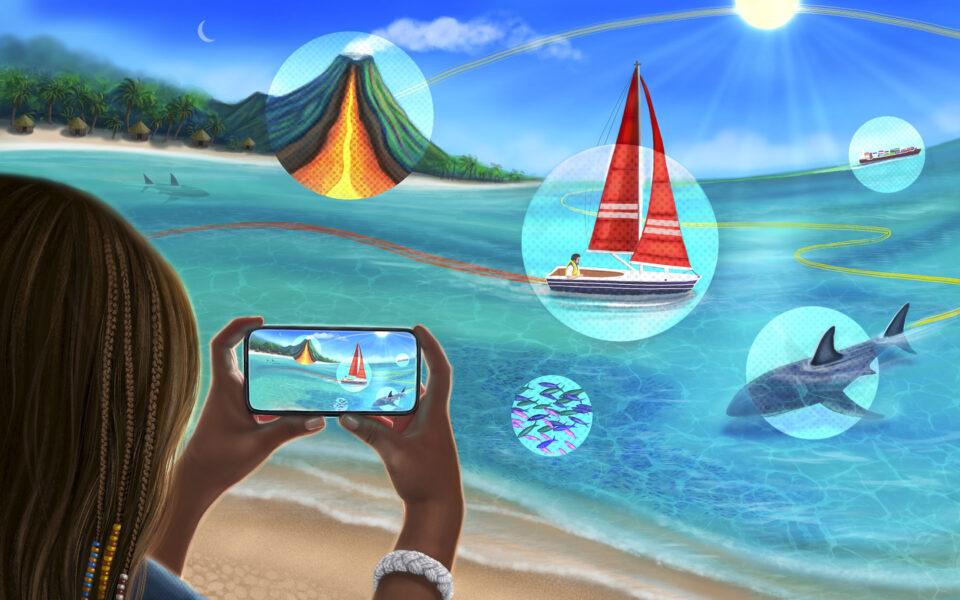Tracking ships (and sharks) and tying knots: Apps to enrich your seaside vacation

Of all summer’s pleasures, few are as irresistible as a getaway by the water, be it an ocean, lake or city harbor. You can swim, sail, fish and partake of the age-old tradition of lazing around.
But a coastal vacation is also an opportunity for discovery. Maybe you’d like to learn how to tie fishing and boating knots? Or decipher those colorful signal flags you see on ships and in seaside shops? With the right app you can turn a holiday on the water into something deeper: identify the fish you’ve just caught or the ship that’s passing by, find out about the seashell you’ve spotted or the lake you’re diving into, explore nearby shark migrations, and study the rhythms of the moon and tides, all while keeping your toes in the sand.
– Track ships on the horizon
Watching a ship glide into a harbor one evening I wondered aloud where it might have been. “Let’s find out,” said a friend, who then pulled out his phone and opened MarineTraffic – Ship Tracking, an app that can identify vessels near and far.
The app’s live map lets you zoom in and out of major ports and shipping routes around the world to see ships, their details and voyage routes. Each vessel is represented by a colored icon, including dark blue for passenger vessels, orange for fishing vessels, and purple for yachts and pleasure craft. For example, while looking at a Norwegian cruise ship on the Hudson River in New York, I opened the map (there’s a desktop version at MarineTraffic.com), tapped on the corresponding icon and was immediately shown a photo of the ship with information such as its name, flag, last known port (it had been at Kings Wharf in Bermuda two days earlier), speed and status (it was moored as opposed to, say, underway, using an engine). Later, when the ship was departing, I opened the app and saw with a glance that it was now on its way to Norfolk, Virginia. (You can also search for a particular vessel by name.)
Cost: free; $9.99 a year for a “starter” subscription with more vessel and port information, and features like an augmented reality tool to identify ships using your smartphone camera. Note: The app uses a network of coastal Automatic Identification System (AIS) receivers to show vessel positions. It costs extra to unlock details for a vessel that’s out of its AIS range.
– Try your hand at boating and knots
Planning on boating, fishing or camping this summer? Knots 3D uses color animations to teach you how to tie more than 150 knots, from those that might help you catch a fish to those that might help save your life. Read about the usage and history of the knots, adjust the speed of the animations or pause them, rotate a knot for a different perspective and use your finger to tie and untie it. There are several ways to search for knots you want to master, including by category (such as boating, fishing and camping) or knot type (like anchor hitch, bowline and fisherman’s eye). Plus, the app doesn’t require internet service, so you can practice even while you’re in the backcountry.
Cost: $5.99.
– Follow sharks from your beach chair
You never know what creatures might be sharing the waters with you on your summer vacation. Or do you?
An app from Ocearch, a nonprofit that facilitates ocean and fish research worldwide, allows users to follow the migrations of sharks (and some other marine animals, like turtles) that have been tagged with satellite tracking technology. For instance, in July I could see on the app’s map that an 883-pound white shark more than 11 feet long was in the Atlantic Ocean off a nearby beach. The app enables you to follow such sharks as they travel thousands of miles (select “all pings” on the app’s map to view both historical and recent tracking activity). Meanwhile, data gathered from tracking helps scientists understand the sharks’ migration patterns and life cycle to better help protect them and, ultimately, the oceans, too.
Cost: free.
– Dive into the history of oceans and lakes
Open Earth 3D – World Atlas for a virtual globe that spins with the swipe of a finger, allowing you to investigate wherever you are – or long to be. On a Great Lakes vacation in Wisconsin? Tap on Lake Superior to read about the first people who came to the region thousands of years ago. On the coast of South Carolina? Tap the Atlantic Ocean to find out just how big it is. Or touch the Caribbean Current to discover where it flows. Vacationing in a major city? Tap a monument or landmark, like the Key West Lighthouse in Florida, to learn about it.
The information about the places comes from Wikipedia, which is easily accessible on the web. And Earth 3D lacks the granularity of, say, the Google Earth app. Nonetheless, it’s a charming, eye-pleasing way to spark interest in geography and history, especially in young people.
Cost: $2.99.
(For a quirkier compendium, try the Atlas Obscura Travel Guide app, on which you can discover lesser-known points of interest around you or elsewhere in the world on an interactive map. And you can’t beat the price: free.)
– Identify shells and other seaside finds
Let’s say you’re strolling along the shore when you spot an unfamiliar object. Whether it’s a shell, piece of coral, plant or bug, try consulting Google Lens. Just point your smartphone camera at whatever it is you’d like to know about and Lens will search the internet for visual matches and information. When recently aimed at a shell, for example, it found pages with photos that revealed it was likely a moon snail.
You can also direct your camera toward a building or a statue to discover its history. And you don’t have to do it in real time either: Lens works on images in photos, too. Some objects turn up more useful results than others, but undoubtedly Lens is a powerful tool. Available as an app for Android; iOS users can download the Google app, which enables you to search with images using Lens.
Cost: free.
– Decode the sights and sounds of the harbor
This digital reference manual for boaters offers information about essential matters like preventing collisions. But even beachgoers who never set foot on board can use Navigation Rules Pro to decode the sights and sounds of a vacation by the sea. For example, you can find out what those colorful flags and pennants mean (and how each one corresponds to a letter) with the app’s guide to the International Code of Signals, a system that vessels use to communicate. Just type “ICS” in the search function to read about the ways signals can be sent, and to see flag images, their meanings, associated letters and phonetic alphabet letters.
Or maybe you want to study International Morse code by using the app’s charts of dots and dashes (just search for “Morse”), or learn more about the Earth and its coordinates by selecting the “nautical charts” section. A lot of this information can be found free online, though the app houses it in one place. So you can sit at a harborside bar and peruse things you’re curious about – like how waves form at sea – with one hand while nursing a beer with the other. For iOS only.
Cost: $4.99.
– Get in Tune with the moon and tides
Keeping track of time may not be necessary on every type of vacation, but if you’re hoping to catch the sunrise or to cross a sandbar before high tide, a bit of planning is in order. Tides Near Me makes it a breeze to check currents and to get the time of the next tide, sunset or moonrise. Look further ahead by tapping the “week” tab.
Cost: free.
For a more refined experience, consider spending a few dollars on Tide Alert (NOAA) – USA, which has an inviting, interactive interface and uses tide forecast data from the National Oceanic and Atmospheric Administration. A chart with an undulating line represents high and low tides. A yellow dot on the line indicates the current time and tide height. You can use your finger to drag the yellow dot forward or backward, virtually traveling back in time to see what the tides were or forward to see what they are forecast to be. Moon and sun icons on the chart show you sunrise, sunset, moonrise and moonset times. You can also see that information at a glance by tapping “rise & set.” To see monthly moon phase calendars, touch the calendar icon. iOS only.
Cost: free trial period, then $3.99 for three months; $11.99 a year.
Surfers may also want to take a look at the MSW Surf Forecast app by Magicseaweed for forecasts that include surf and swell height.
Cost: free. An ad-free, pro version with features like live surf cams from around the world is available for $12.99 a month; $99.99 a year (free pro trial available).
And if you’re planning to go fishing, check out the FishAngler app to explore fishing spots and see tide phase and barometric pressure charts, weather and wind conditions, sun and moon states, as well as a “fish forecast” that suggests the best times to fish based on Solunar Tables (how the moon and sun may affect anglers). Even if you don’t manage to catch anything, you can use the app to learn about top species in your region, be it an American anglerfish or a Yellowtail snapper.
Cost: free.
This article originally appeared in The New York Times.






